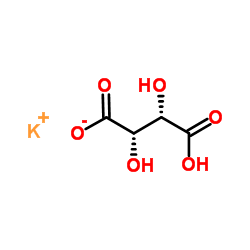921-53-9
| 中文名 | 酒石酸钾 |
|---|---|
| 英文名 | potassium L-tartrate |
| 英文别名 |
POTASSIUM L-TARTRATE
Butanedioic acid, 2,3-dihydroxy-, potassium salt, (2S,3S)- (1:1) MFCD00013065 Potassium (2S,3S)-3-carboxy-2,3-dihydroxypropanoate KALIUM(+)-TARTRAT, SLR, EXTRA PURE BUTANEDIOICACID, 2,3-DIHYDROXY- (2R,3R)-, POTASSIUM SALT (1:2) POTASSIUM L-TARTRATE HEMIHYDRATE/L-TARTARIC ACID DIPOTASSIUM SALT DIPOTASSIUM TARTRATE PotassiumD-tartratemonobasic L-(+)-TARTARIC ACID DIPOTASSIUM SALT Potassium tartrate hemihydrate POTASSIUMTARTRATE Potassium tartrate, hydrate Potassium Tartrate EINECS 212-769-1 |
| 密度 | 1.98 |
|---|---|
| 沸点 | 399.3ºC at 760mmHg |
| 熔点 | 155 °C |
| 分子式 | C4H5KO6 |
| 分子量 | 188.177 |
| 闪点 | 209.4ºC |
| 精确质量 | 187.972321 |
| PSA | 117.89000 |
| 外观性状 | 白色结晶粉末 |
| 储存条件 | 常温 ,避光,通风干燥处,密封保存 |
| 稳定性 | 常温常压下稳定 白色结晶或结晶性粉末。150℃失水。200~220℃分解。溶于约0.5份水,几乎不溶于乙醇。水溶液对石蕊呈微碱性,pH7~8。相对密度1.98。 |
| 计算化学 | 1、 疏水参数计算参考值(XlogP):未确定 2、 氢键供体数量:2 3、 氢键受体数量:6 4、 可旋转化学键数量:1 5、 互变异构体数量:未确定 6、 拓扑分子极性表面积(TPSA):121 7、 重原子数量: 12 8、 表面电荷:0 9、 复杂度:123 10、 同位素原子数量:0 11、 确定原子立构中心数量:2 12、 不确定原子立构中心数量:0 13、 确定化学键立构中心数量:0 14、 不确定化学键立构中心数量:0 15、 共价键单元数量:3 |
| 更多 | 1. 性状:白色结晶 2. 密度(g/mL,15℃):1.954 3. 相对蒸汽密度(g/mL,空气=1):未确定 4. 熔点(ºC):未确定 5. 沸点(ºC,常压):未确定 6. 折射率:未确定 7. 闪点(ºC):200-220 8. 自燃点或引燃温度(ºC):未确定 9. 蒸气压(kPa,25ºC):未确定 10. 饱和蒸气压(kPa,60ºC):未确定 11. 燃烧热(KJ/mol):未确定 12. 临界温度(ºC):未确定 13. 临界压力(KPa):未确定 14. 油水(辛醇/水)分配系数的对数值:未确定 15. 爆炸上限(%,V/V):未确定 16. 爆炸下限(%,V/V):未确定 17. 溶解性:溶于约0.5份水,几乎不溶于乙醇 |
Synonym:Potassium biborate, Potassium Hydrogen Tartrat Section 2 - COMPOSITION, INFORMATION ON INGREDIENTS
Risk Phrases: None Listed. Section 3 - HAZARDS IDENTIFICATION EMERGENCY OVERVIEW
The toxicological properties of this material have not been fully investigated. Potential Health Effects Eye: May cause eye irritation. Skin: May cause skin irritation. Ingestion: May cause irritation of the digestive tract. The toxicological properties of this substance have not been fully investigated. Inhalation: May cause respiratory tract irritation. The toxicological properties of this substance have not been fully investigated. Chronic: No information found. Section 4 - FIRST AID MEASURES Eyes: Flush eyes with plenty of water for at least 15 minutes, occasionally lifting the upper and lower eyelids. Get medical aid. Skin: Flush skin with plenty of water for at least 15 minutes while removing contaminated clothing and shoes. Get medical aid if irritation develops or persists. Ingestion: If victim is conscious and alert, give 2-4 cupfuls of milk or water. Never give anything by mouth to an unconscious person. Get medical aid. Inhalation: Remove from exposure and move to fresh air immediately. If not breathing, give artificial respiration. If breathing is difficult, give oxygen. Get medical aid. Notes to Physician: Section 5 - FIRE FIGHTING MEASURES General Information: As in any fire, wear a self-contained breathing apparatus in pressure-demand, MSHA/NIOSH (approved or equivalent), and full protective gear. During a fire, irritating and highly toxic gases may be generated by thermal decomposition or combustion. Extinguishing Media: Use water spray, dry chemical, carbon dioxide, or chemical foam. Section 6 - ACCIDENTAL RELEASE MEASURES General Information: Use proper personal protective equipment as indicated in Section 8. Spills/Leaks: Vacuum or sweep up material and place into a suitable disposal container. Section 7 - HANDLING and STORAGE Handling: Wash thoroughly after handling. Wash hands before eating. Use with adequate ventilation. Avoid contact with eyes, skin, and clothing. Avoid ingestion and inhalation. Storage: Store in a cool, dry place. Store in a tightly closed container. Section 8 - EXPOSURE CONTROLS, PERSONAL PROTECTION Engineering Controls: Facilities storing or utilizing this material should be equipped with an eyewash facility and a safety shower. Exposure Limits CAS# 921-53-9: Personal Protective Equipment Eyes: Wear chemical splash goggles. Skin: Wear appropriate protective gloves to prevent skin exposure. Clothing: Wear a chemical apron. Respirators: Follow the OSHA respirator regulations found in 29 CFR 1910.134 or European Standard EN 149. Use a NIOSH/MSHA or European Standard EN 149 approved respirator if exposure limits are exceeded or if irritation or other symptoms are experienced. Section 9 - PHYSICAL AND CHEMICAL PROPERTIES Physical State: Solid Color: white Odor: None reported. pH: Not available. Vapor Pressure: Not available. Viscosity: Not available. Boiling Point: Not available. Freezing/Melting Point: 200-220 C Autoignition Temperature: Not applicable. Flash Point: Not applicable. Explosion Limits, lower: Not available. Explosion Limits, upper: Not available. Decomposition Temperature: Not available. Solubility in water: Soluble in water. Specific Gravity/Density: Not available. Molecular Formula: CH(OH)COOK.0.5H2O Molecular Weight: 130.1169 Section 10 - STABILITY AND REACTIVITY Chemical Stability: Stable under normal temperatures and pressures. Conditions to Avoid: Incompatible materials. Incompatibilities with Other Materials: Strong oxidizing agents and strong acids Hazardous Decomposition Products: Carbon monoxide, irritating and toxic fumes and gases, carbon dioxide, oxides of potassium. Hazardous Polymerization: Has not been reported. Section 11 - TOXICOLOGICAL INFORMATION RTECS#: CAS# 921-53-9 unlisted. LD50/LC50: Not available. Carcinogenicity: Potassium (+) Tartrate - Not listed by ACGIH, IARC, or NTP. Section 12 - ECOLOGICAL INFORMATION Section 13 - DISPOSAL CONSIDERATIONS Products which are considered hazardous for supply are classified as Special Waste and the disposal of such chemicals is covered by regulations which may vary according to location. Contact a specialist disposal company or the local waste regulator for advice. Empty containers must be decontaminated before returning for recycling. Section 14 - TRANSPORT INFORMATION IATA Not regulated as a hazardous material. IMO Not regulated as a hazardous material. RID/ADR Not regulated as a hazardous material. Section 15 - REGULATORY INFORMATION European/International Regulations European Labeling in Accordance with EC Directives Hazard Symbols: Not available. Risk Phrases: Safety Phrases: WGK (Water Danger/Protection) CAS# 921-53-9: 1 Canada CAS# 921-53-9 is listed on Canada's DSL List. CAS# 921-53-9 is not listed on Canada's Ingredient Disclosure List. US FEDERAL TSCA CAS# 921-53-9 is listed on the TSCA inventory. SECTION 16 - ADDITIONAL INFORMATION N/A |
|
生态学数据: 通常对水是不危害的,若无政府许可,勿将材料排入周围环境
|
| 危害码 (欧洲) | Xn |
|---|---|
| 安全声明 (欧洲) | S22-S24/25 |
| WGK德国 | 1 |
| RTECS号 | WW8223000 |


